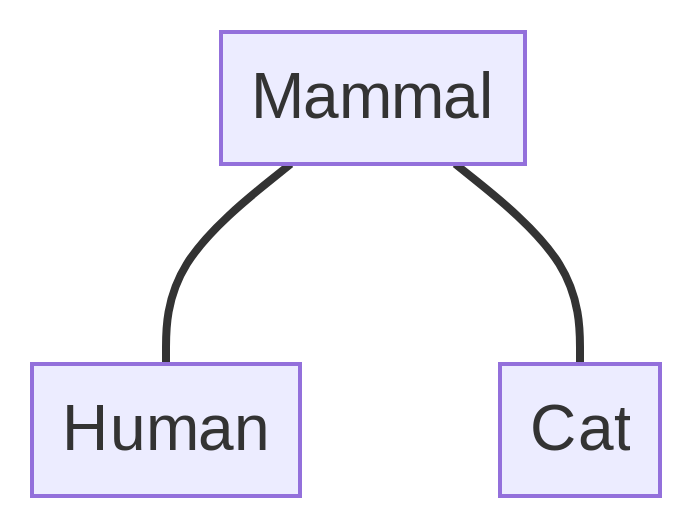
Programming best practices
Agent-based modelling, Konstanz, 2024
Henri Kauhanen
21 May 2024
Plan
- This week, we will look at a few practices that have the potential to make your code better
- Here, “better” can mean:
- more logical organization of code
- better performance (faster running, and/or less memory consumption)
- In addition, we will wrap up the first half of the course and talk about any issues/challenges you may have run into
Note
Today’s lecture requires the following Julia packages:
- Agents
- BenchmarkTools
- Random
It would be a good idea to install them now, if your system does not already have them.
Plan
- The “best practices” bit of today’s session is broken down into three major topics:
- Abstract types, inheritance and multiple dispatch
- Benchmarking
- Random numbers
Abstract types and inheritance
- Some weeks ago, we defined a variational learner type which lives in an unstructured population
- Last week, we defined one that lives in a grid space
Abstract types and inheritance
- Two possible strategies:
- Name both types
VariationalLearner- pro: we can reuse the functions we’ve written that take
VariationalLearnerobjects as arguments, such asspeak,learn!andinteract! - con 1: we can’t use both types in the same code
- con 2: Julia does not deal well with type redefinitions, forcing a restart when moving from one definition to the other
- pro: we can reuse the functions we’ve written that take
Abstract types and inheritance
- Two possible strategies:
- Give the new type a new name, such as
GridVL- pro: no complaints from Julia
- con: we can’t reuse our functions, since they’re defined for
VariationalLearnerobjects
Abstract types and inheritance
- A neat solution to this problem is to start thinking about type hierarchies
- Intuitively: types can have hierarchical relationships, a bit like biological taxonomies
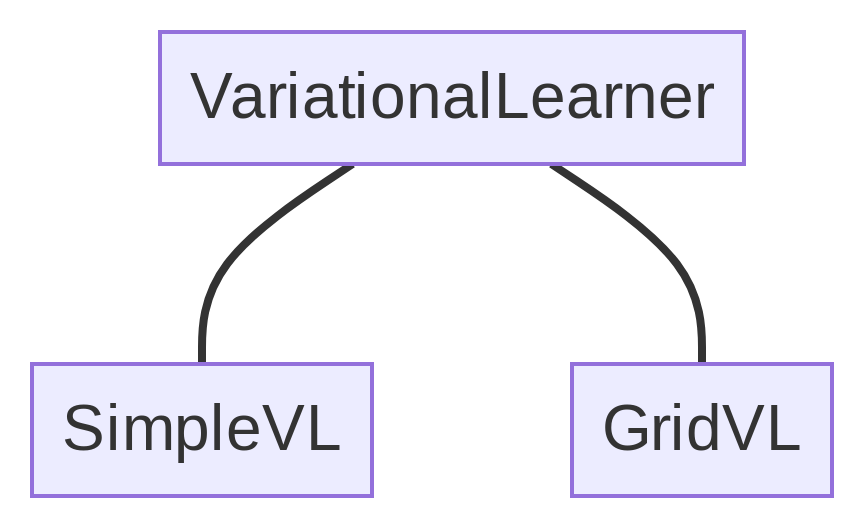
Abstract types and inheritance
Important
From now on, I will use SimpleVL to refer to our original VariationalLearner, i.e. the type that lives in an unstructured population.
VariationalLearner from now on will denote the supertype of all “variational learnery” things.
Abstract types and inheritance
- The point of this is: a function can be defined for the supertype, whose subtypes then inherit that function
- E.g. we can define a
sleepfunction forMammal - Both
HumanandCatinherit this function, and so we don’t need to define one for them separately
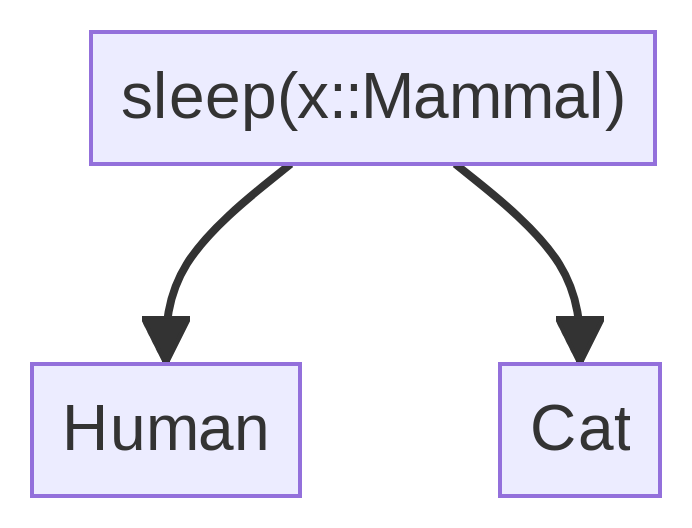
Abstract types and inheritance
- Similarly, we can define
speakfor the supertypeVariationalLearner - Then both
SimpleVLandGridVLhave access to this function
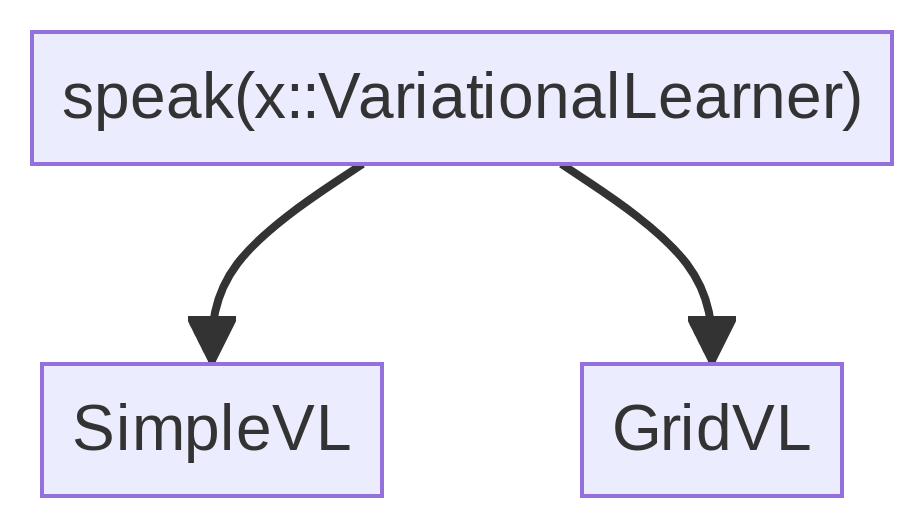
Abstract types and inheritance
- In Julia such “supertypes” are known as abstract types
- They have no fields; they only exist to define the type hierarchy
- Inheritance relations are defined using a special
<:operator - To use Agents.jl, our
VariationalLearnerabstract type itself needs to inherit fromAbstractAgent
Abstract types and inheritance
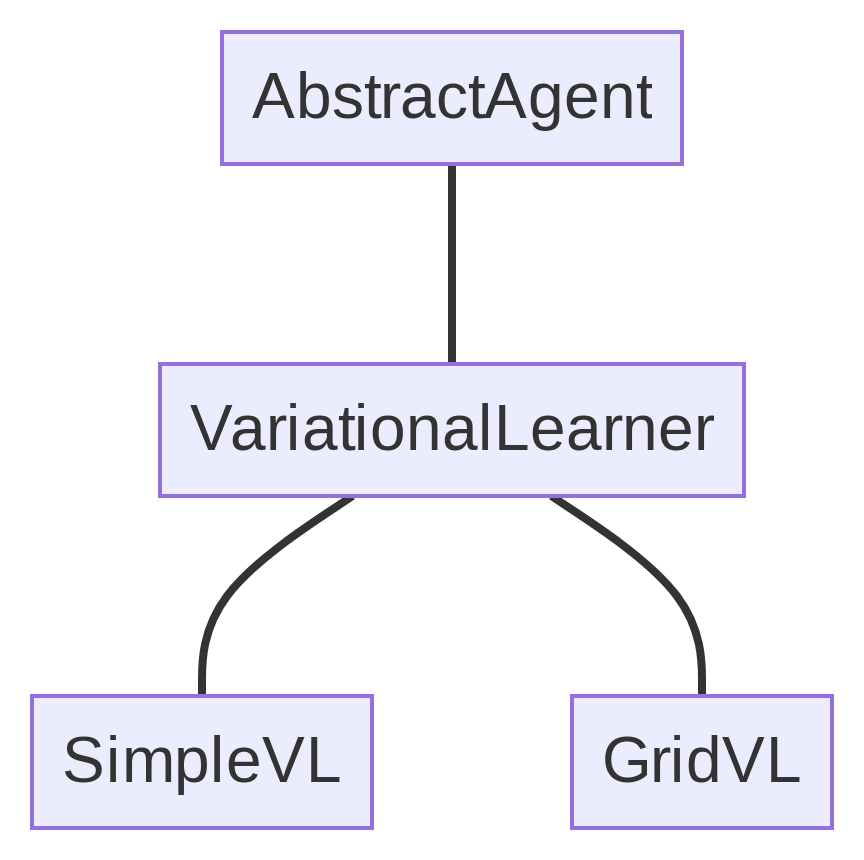
Abstract types and inheritance
Abstract types and inheritance
- We can now do things like:
even though speak wasn’t defined for SimpleVL
Multiple dispatch
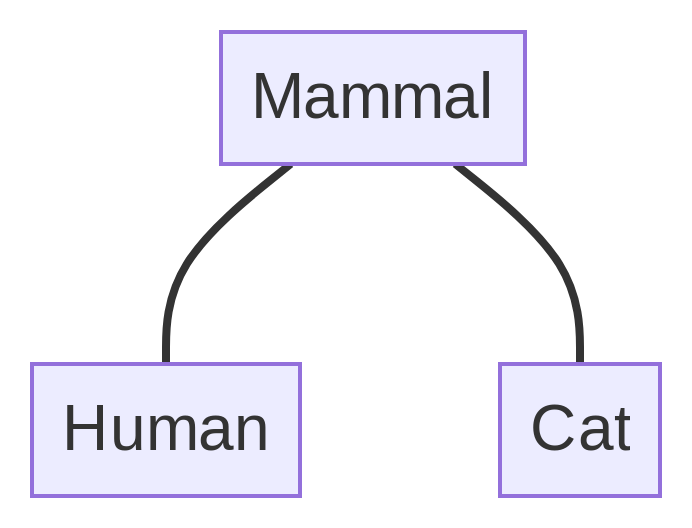
- What if
Catneeds to sleep differently from otherMammals? - Easy: we simply define a function
sleep(x::Cat) - Other
Mammals will use the default functionsleep(x::Mammal)
Multiple dispatch
- In Julia, this is called multiple dispatch
- One and the same function (here,
sleep) can have multiple definitions depending on the argument’s type - These different definitions are known as methods of the function
- When figuring out which method to use, the compiler tries to apply the method that is deepest in the type hierarchy, moving upwards if such a definition isn’t found
- e.g. in our example calling
sleeponHumanwill trigger thesleepmethod defined forMammal, since nosleepmethod specific toHumanhas been defined
- e.g. in our example calling
Our VL code so far
module VL
# Agents.jl functionality
using Agents
# we need this package for the sample() function
using StatsBase
# we export the following types and functions
export VariationalLearner
export SimpleVL
export GridVL
export speak
export learn!
export interact!
export VL_step!
# abstract type
abstract type VariationalLearner <: AbstractAgent end
# variational learner type on a 2D grid
@agent struct GridVL(GridAgent{2}) <: VariationalLearner
p::Float64 # prob. of using G1
gamma::Float64 # learning rate
P1::Float64 # prob. of L1 \ L2
P2::Float64 # prob. of L2 \ L1
end
# "simple" variational learner in unstructured population
mutable struct SimpleVL <: VariationalLearner
p::Float64 # prob. of using G1
gamma::Float64 # learning rate
P1::Float64 # prob. of L1 \ L2
P2::Float64 # prob. of L2 \ L1
end
# makes variational learner x utter a string
function speak(x::VariationalLearner)
g = sample(["G1", "G2"], Weights([x.p, 1 - x.p]))
if g == "G1"
return sample(["S1", "S12"], Weights([x.P1, 1 - x.P1]))
else
return sample(["S2", "S12"], Weights([x.P2, 1 - x.P2]))
end
end
# makes variational learner x learn from input string s
function learn!(x::VariationalLearner, s::String)
g = sample(["G1", "G2"], Weights([x.p, 1 - x.p]))
if g == "G1" && s != "S2"
x.p = x.p + x.gamma * (1 - x.p)
elseif g == "G1" && s == "S2"
x.p = x.p - x.gamma * x.p
elseif g == "G2" && s != "S1"
x.p = x.p - x.gamma * x.p
elseif g == "G2" && s == "S1"
x.p = x.p + x.gamma * (1 - x.p)
end
return x.p
end
# makes two variational learners interact, with one speaking
# and the other one learning
function interact!(x::VariationalLearner, y::VariationalLearner)
s = speak(x)
learn!(y, s)
end
# steps a model
function VL_step!(agent, model)
interlocutor = random_nearby_agent(agent, model)
interact!(interlocutor, agent)
end
end # this closes the moduleBenchmarking
- When working on larger simulations, it is often important to know how long some function takes to run
- It may also be important to know how much memory is consumed
- Both of these things can be measured using the
@benchmarkmacro defined by BenchmarkTools.jl
Benchmarking
- Example:
BenchmarkTools.Trial: 10000 samples with 1000 evaluations. Range (min … max): 1.335 ns … 21.823 ns ┊ GC (min … max): 0.00% … 0.00% Time (median): 1.542 ns ┊ GC (median): 0.00% Time (mean ± σ): 1.596 ns ± 0.523 ns ┊ GC (mean ± σ): 0.00% ± 0.00% ▅ ▇ ▆▅ █ ▂▇ ▆▇ ▃▅ ▆ ▆▅ ▆▃ ▂▃ ▂▂▂▃▂▁▁ ▁▁ ▃ █▁█▃██▃█▅██▃██▆██▅███▅██▅▃██▆████████████▆▆▆▇▅▆▇██████▇█▆█ █ 1.34 ns Histogram: log(frequency) by time 2.26 ns < Memory estimate: 0 bytes, allocs estimate: 0.
All roads lead to Rome, but they’re not all equally fast…
- Suppose we want to calculate the square root of all numbers between 0 and 100,000 and put them in an array
- One way of doing this:
All roads lead to Rome, but they’re not all equally fast…
@benchmark begin
result = [] # empty array
for x in 0:100_000
append!(result, sqrt(x)) # put √x in array
end
endBenchmarkTools.Trial: 3134 samples with 1 evaluation. Range (min … max): 1.235 ms … 5.818 ms ┊ GC (min … max): 0.00% … 52.82% Time (median): 1.413 ms ┊ GC (median): 0.00% Time (mean ± σ): 1.592 ms ± 511.088 μs ┊ GC (mean ± σ): 8.51% ± 14.51% ▁▃▆█▇▅▂▁ ▃▄▃ ▁ █████████▇▄▆███▇▆▄▅▁▅▅▁▁▁▃▃▆▆▇▇▆▅▁▅▁▇▇██▇▇▇▆▆▅▆▆▃▃▃▃▄▇▇▆▇▅▆ █ 1.24 ms Histogram: log(frequency) by time 3.82 ms < Memory estimate: 3.35 MiB, allocs estimate: 100012.
All roads lead to Rome, but they’re not all equally fast…
- Another way:
All roads lead to Rome, but they’re not all equally fast…
@benchmark begin
result = zeros(100_000 + 1)
for x in 0:100_000
result[x+1] = sqrt(x) # put √x in array
end
endBenchmarkTools.Trial: 10000 samples with 1 evaluation. Range (min … max): 100.037 μs … 689.957 μs ┊ GC (min … max): 0.00% … 49.59% Time (median): 102.822 μs ┊ GC (median): 0.00% Time (mean ± σ): 114.841 μs ± 44.015 μs ┊ GC (mean ± σ): 3.94% ± 8.72% █▃▁▂▃▂▁▁▂▁▁▁▁▁▁ ▁ ████████████████▇█▆▆▆▅▅▄▁▄▃▁▄▁▁▁▁▁▁▁▁▁▁▁▁▁▁▁▁▁▁▁▁▁▁▃▃▅▃▄▅▅▇▇█ █ 100 μs Histogram: log(frequency) by time 372 μs < Memory estimate: 781.36 KiB, allocs estimate: 2.
All roads lead to Rome, but they’re not all equally fast…
- A third possibility:
All roads lead to Rome, but they’re not all equally fast…
BenchmarkTools.Trial: 10000 samples with 1 evaluation. Range (min … max): 78.327 μs … 654.640 μs ┊ GC (min … max): 0.00% … 49.57% Time (median): 79.472 μs ┊ GC (median): 0.00% Time (mean ± σ): 87.674 μs ± 32.322 μs ┊ GC (mean ± σ): 3.61% ± 8.48% █▂▁▁▁▃▁ ▁ ▁ ████████▆█▇█▇▇▇█▇█▆▆█▇▆▃▃▄▁▄▁▃▁▁▁▁▁▁▃▁▁▁▁▁▁▁▁▁▁▁▁▁▁▁▁▁▆▇▇▇▆▅ █ 78.3 μs Histogram: log(frequency) by time 275 μs < Memory estimate: 781.36 KiB, allocs estimate: 2.
All roads lead to Rome, but they’re not all equally fast…
- A fourth way:
All roads lead to Rome, but they’re not all equally fast…
BenchmarkTools.Trial: 10000 samples with 1 evaluation. Range (min … max): 78.441 μs … 605.374 μs ┊ GC (min … max): 0.00% … 48.05% Time (median): 79.186 μs ┊ GC (median): 0.00% Time (mean ± σ): 87.363 μs ± 31.767 μs ┊ GC (mean ± σ): 3.71% ± 8.67% █▁▁▁▂▃▁ ▁▁ ▁ ▁ ████████▇█████▇███▆▆▆▅▄▁▁▃▁▁▁▁▁▁▁▁▁▁▁▁▁▁▁▁▁▁▁▁▁▁▁▁▁▁▁▁▁▅▇█▇▆ █ 78.4 μs Histogram: log(frequency) by time 274 μs < Memory estimate: 781.36 KiB, allocs estimate: 2.
Summing up the findings
| Procedure | Median time | Mem. estimate |
|---|---|---|
| Growing an array | ~1.4 ms | ~3.4 MiB |
| Adding to 0-array | ~0.1 ms | ~0.8 MiB |
| Array comprehension | ~80 µs | ~0.8 MiB |
| Broadcasting | ~80 µs | ~0.8 MiB |
Summing up the findings
- Lesson: try to avoid growing (and shrinking!) arrays whenever possible
- Of course, sometimes this is practically unavoidable (such as when adding and removing agents from a population)
- Another lesson: if procedure X gets repeated very many times in a simulation, try to make X as efficient as possible
- Procedures which are only carried out once or a few times (such as initializing a population) don’t matter so much
Random numbers
- In the first lecture, we talked about the importance of (pseudo)random numbers in ABM simulations
- E.g. whenever an agent needs to be sampled randomly, the computer needs to generate a random number
- There are two important issues here:
- Reproducibility – how to obtain the same sequence of “random” numbers if this is desired
- Consistency – making sure that whenever a random number is drawn, it is drawn using the same generator (i.e. from the same sequence)
Reproducibility
- Recall: a PRNG (pseudorandom number generator) generates a deterministic sequence which appears random
- The sequence is generated from an initial seed number
- If you change the seed, you obtain different sequences
- Normally, when Julia is started, the PRNG is seeded with a different seed every time
- Hence, you obtain different sequences
Reproducibility: illustration
- To illustrate this, suppose you want to toss a coin 10 times. This is easy:
Reproducibility: illustration
- Now restart Julia and execute the same thing. You will get a different result:
Reproducibility: illustration
- If you want to make sure the exact same sample is obtained, you can seed the PRNG manually after startup
- For example, seed with the number 123:
Reproducibility
- Why would you do this? Wasn’t randomness kind of the point?
- Suppose someone (e.g. your supervisor, or an article reviewer) wants to check that your code actually produces the results you have reported
- Using a manually seeded PRNG makes this possible
Consistency
- It is possible to have multiple PRNGs running simultaneously in the same code
- This is rarely desired, but may happen by mistake…
- For example, when you call
StandardABM, Agents.jl will set up a new PRNG by default - If your own functions (such as
speakorlearn!) utilize a different PRNG, you may run into problems- For one, it will be difficult to ensure reproducibility
Consistency
- To avoid this, pass
Random.default_rng()as an argument toStandardABMwhen creating your model:
Reminder: not all agents are humans!
Looking ahead
- Homework:
- Keep thinking about your project!
- Read Smaldino (2023), chapter 10
Looking ahead
- The following two weeks constitute a break for us: the first one is the lecture-free period, the second one is consolidation week (“Vertiefungswoche”)
- After this break, you need to
- have a project team (or have decided to work on your own)
- have at least an initial idea about your project topic
- If you struggle, I’m happy to help! You can always write me an email, and/or come to see me in my office.
References
Smaldino, Paul E. 2023. Modeling Social Behavior: Mathematical and Agent-Based Models of Social Dynamics and Cultural Evolution. Princeton, NJ: Princeton University Press.